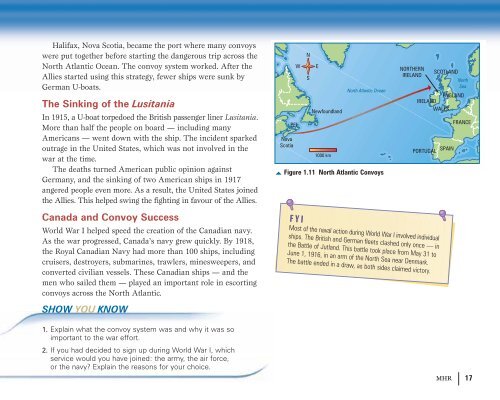Download Unit 1 Student Text Sample Material - McGraw-Hill Ryerson
Download Unit 1 Student Text Sample Material - McGraw-Hill Ryerson
Download Unit 1 Student Text Sample Material - McGraw-Hill Ryerson
Create successful ePaper yourself
Turn your PDF publications into a flip-book with our unique Google optimized e-Paper software.
Halifax, Nova Scotia, became the port where many convoys<br />
were put together before starting the dangerous trip across the<br />
North Atlantic Ocean. The convoy system worked. After the<br />
Allies started using this strategy, fewer ships were sunk by<br />
German U-boats.<br />
The Sinking of the Lusitania<br />
In 1915, a U-boat torpedoed the British passenger liner Lusitania.<br />
More than half the people on board — including many<br />
Americans — went down with the ship. The incident sparked<br />
outrage in the <strong>Unit</strong>ed States, which was not involved in the<br />
war at the time.<br />
The deaths turned American public opinion against<br />
Germany, and the sinking of two American ships in 1917<br />
angered people even more. As a result, the <strong>Unit</strong>ed States joined<br />
the Allies. This helped swing the fighting in favour of the Allies.<br />
Canada and Convoy Success<br />
World War I helped speed the creation of the Canadian navy.<br />
As the war progressed, Canada’s navy grew quickly. By 1918,<br />
the Royal Canadian Navy had more than 100 ships, including<br />
cruisers, destroyers, submarines, trawlers, minesweepers, and<br />
converted civilian vessels. These Canadian ships — and the<br />
men who sailed them — played an important role in escorting<br />
convoys across the North Atlantic.<br />
SHOW YOU KNOW<br />
PEI<br />
Nova<br />
Scotia<br />
W<br />
N<br />
S<br />
E<br />
Newfoundland<br />
1000 km<br />
North Atlantic Ocean<br />
Figure 1.11 North Atlantic Convoys<br />
FYI<br />
NORTHERN<br />
IRELAND<br />
PORTUGAL<br />
Most of the naval action during World War I involved individual<br />
ships. The British and German fleets clashed only once — in<br />
the Battle of Jutland. This battle took place from May 31 to<br />
June 1, 1916, in an arm of the North Sea near Denmark.<br />
The battle ended in a draw, as both sides claimed victory.<br />
SCOTLAND<br />
SPAIN<br />
North<br />
Sea<br />
ENGLAND<br />
IRELAND<br />
WALES<br />
FRANCE<br />
1. Explain what the convoy system was and why it was so<br />
important to the war effort.<br />
2. If you had decided to sign up during World War I, which<br />
service would you have joined: the army, the air force,<br />
or the navy Explain the reasons for your choice.<br />
MHR<br />
17

















